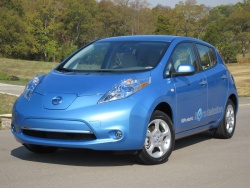 2012 Nissan Leaf. Click image to enlarge |
|
Related articles on Autos
Manufacturer’s web site
|
Review and photos by Paul Williams
Photo Gallery:
2012 Nissan Leaf
True to his word, Nissan CEO Carlos Ghosn has brought a production electric vehicle (EV) to market. It has almost made it to Canada; not quite… but very soon.
The Nissan Leaf is a zero-emission compact car that is powered by an electric motor making an equivalent 107 horsepower and 206 pound-feet of torque. It is the first mass-produced, available for purchase, all-electric family vehicle of the modern era.
The Leaf’s motor is located under the hood, mated to a single speed gear reducer (like a gearbox) that drives the front wheels. The 273 kilogram lithium-ion battery that powers the motor is located in the middle of the car, between the sills and underneath the seats. The battery is charged by regenerative braking when the Leaf is driven, and by plugging it into a 120 or 240-volt outlet (Level 1 and 2), or a special Direct Current (DC) electrical source (Level 3). The battery will have an eight-year, 160,000 kilometre warranty, and an expected life of 10 years.
The Leaf is a “fully realized” family vehicle. It is a four-door hatchback with five-passenger seating that will be available in SV and SL trim levels. No special skills are required to drive it, and no compromises are evident in terms of interior packaging and occupant amenities. In fact, the Leaf SV – for which Canadian pricing has not yet been announced – is packed with an impressive amount of standard equipment including a navigation system, vehicle stability control, automatic climate control, a comprehensive trip computer with colour display, 16-inch alloy wheels, LED headlights, rear spoiler, Bluetooth, intelligent key push-button start and the ability to interface with your mobile device to control charging, pre-heating and pre-cooling.
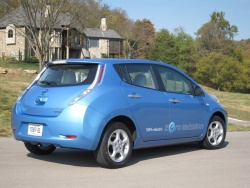 2012 Nissan Leaf. Click image to enlarge |
The SL model adds a rear-view monitor, fog lights, solar panel charger (for a supplementary 12V battery that powers accessories), homelink transceiver and cargo cover. A cold-weather package will be standard in Canada.
The range of the Leaf is limited by access to stations where it can be charged, by driving style and by the conditions in which it is operated. A fully charged Leaf can travel up to 220 kilometres, for example, at a steady speed of 60 km/h with moderate use of interior amenities. However, with the air conditioning or heating set to “high” in demanding traffic, the Leaf’s range is considerably reduced (to approximately 100 km). The U.S. Environmental Protection Agency rates Leaf’s expected range at 160 km (the LA4 mode).
The driver is always aware, however, of the battery’s charge, and of the available driving range before a recharge is required. In everyday use, a fully charged Leaf would be sufficient to handle an average commute to work, along with several local trips (shopping, entertainment, chores) before being parked for the night and plugged in to recharge.
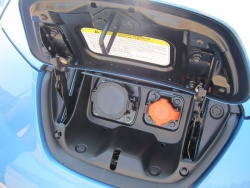 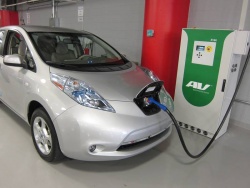 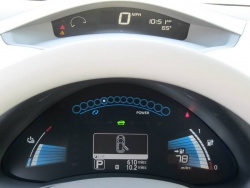 2012 Nissan Leaf. Click image to enlarge |
Clearly, though, the Leaf as currently offered wouldn’t be an appropriate vehicle for persons who require a vehicle to drive long distances. As such, it should be regarded as a vehicle for local use only; likely a second or third car in the family fleet.
Charging the Leaf is not difficult. The first method (Level 1) is to simply plug the leaf into a standard household 120V service. Using this familiar technology, a Leaf can be brought to full charge in 20 hours. Obviously, while this method may be useful in some circumstances, most Leaf buyers will require a faster charge, necessitating the purchase and installation of the Level 2 240V charging kit (estimated to cost up to $2,000). This is the same current used to power a stove or dryer in one’s home, although a specialized intelligent receptacle is utilized for the Leaf. A full Level 2 charge takes eight hours.
Both of these charging methods – 120V and 240V – would ideally be used in a home garage, where local building codes permit the installation of a 240V service, or additionally in the case of the 240V charging stations, in public locations established for this purpose.
The third charging option — Level 3 — is a 600V DC (direct current) station that would quick-charge the Leaf to 80 per cent in as little as 30 minutes. Such stations would likely be established as commercial enterprises, should demand for the Leaf materialize as Nissan expects.
Fully charging the Leaf requires 24 kilowatt/hours (kW/h) of electricity, with the price of a one kW/h varying both geographically, temporally and seasonally. At six cents per kW/h, for example, it would cost $1.40 to charge the Leaf. Four-to-five-hundred kilometres of travel — what you can expect from a tank of gasoline in a conventional compact vehicle — would therefore cost around five dollars. Annual “fuel” costs, therefore, would work out to around $200 for 20,000 km of driving.







 Follow Autos on Twitter
Follow Autos on Twitter

